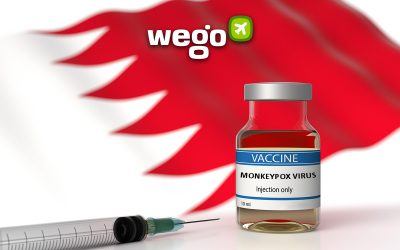This article has been reviewed by Wego’s editorial team to ensure that the content is up to date & accurate.
Updated 02 August 2022
The World Health Organization (WHO) has recently declared the spread of Monkeypox a ‘global health emergency’ amidst the rising infection rates worldwide. India had reported its first case of Monkeypox in July 2022. Below, we have gathered all the information that you need about the Monkeypox virus in India. Read further to find out.

Table of Contents
What is Monkeypox?
Monkeypox is a viral zoonotic disease that occurs primarily in tropical rainforest areas of Central and West Africa and is occasionally exported to other regions.
Monkeypox is transmitted from one person to another by close contact with lesions, body fluids, respiratory droplets and contaminated materials such as clothing, bedding, or other items used in healthcare settings.
In most cases, people typically recover within two to four weeks without needing to be hospitalized. In some cases, however, monkeypox can also be fatal.
Monkeypox cases in India
As of now, seven cases of the Monkeypox infection have been confirmed. Five cases of infection have been confirmed from Kerala, with the first case being detected on a traveller arriving from UAE in Kerala on 12 July 2022, with the other one in Delhi, and one in Guntur, Andhra Pradesh.
Recently, a 22-year-old infected traveller who returned to India after a trip from UAE passed away due to a Monkeypox infection. The man was hospitalized in Thrissur on July 27 due to extreme exhaustion and brain fever, and he passed away on July 30. His test samples were delivered to Pune’s National Institute of Virology (NIV) for analysis. On Monday, the outcomes were in favour.
As reported by Dr Nivedita Gupta, the head of virology at the Indian Council of Medical Research (ICMR), unlike coronavirus, monkeypox will not spread like wildfire. Although, the recent founding of the virus has made the Government of India step up a vigil across five districts in India, Thiruvananthapuram, Kollam, Pathanamthitta, Alappuzha and Kottayam.
In the Kerala airport, the health measurement has been increased. Any passengers who arrived with symptoms will be isolated and the authorities will arrange an ambulance to transfer them to the hospital.
Dr Abraham, the Director of ICMR stated in an interview that “Monkeypox is not as transmissible as the Covid-19 virus and the present outbreak gives no cause for undue panic. Transmission between humans takes place through close contact with respiratory secretions (large droplets), skin lesions, or recently contaminated objects. Hence, health care workers, members of households, and other close contacts of active cases of monkeypox are at increased risk”.
However, even if it’s not as easily transmissible, Dr PS Indu, professor and head of the department of community medicine at the Government Medical College in Kollam emphasized the importance of surveillance of this virus to prevent a silent transmission.
Moreover, the World Health Organisation Country Office for India has sought the assistance of India’s ICMR-National Institute of Virology, Pune help to test suspected cases of monkeypox for the south-east Asia region (SEAR) member-states.
Monkeypox and India travel restrictions
Currently, India has not established any travel restrictions to prevent the spread of Monkeypox. However, the country’s top health research arm is closely monitoring the global surge of monkeypox virus and evaluating the possible options.
The Central government of India has, however, recently issued guidelines for monkeypox patients in India, including the requirement to undergo a twenty-one days isolation period, wear masks, and follow hand hygiene. The Union government has also stated in its guidelines the need for monkeypox patients to wait for the lesions to fully heal. These guidelines have been issued for the close contact of monkeypox patients as well.
In view of the recent developments, the Centre issued guidelines for monkeypox management. The Delhi government has directed its hospitals and 11 revenue districts to follow the guidelines.
As per the guidelines, health workers who have unprotected exposure to monkeypox patients or possibly contaminated materials need not be excluded from duty if asymptomatic but should undergo surveillance for symptoms for 21 days.
The infected person has to wear a triple-ply mask while the skin lesions should be covered to the best extent possible to minimise the risk of contact with others. Furthermore, the patients should remain in isolation until all lesions have healed and the scabs have completely fallen off.
The officials have further stated that a person who comes in contact with an infected person through face-to-face exposure, direct physical contact, or comes in contact with contaminated materials such as clothing or bedding will be identified as a primary contact.
What are the symptoms of Monkeypox?
Monkeypox has an incubation period from seven to 14 days. The initial symptoms of monkeypox are similar to influenza with fever, chills, exhaustion, headache, muscle weakness and swelling in lymph nodes.
The widespread rashes all over the infected bodies include the inside the mouth, palms of the hands, and feet.
However, it is been reported that the rashes are mostly in the genital area for the early stages of the illness.
Monkeypox prevention
Here are the things that you can do to prevent the spread of Monkeypox:
- Keep your hands clean by washing them for at least 20 seconds with soap and water or alcohol-based hand sanitisers.
- Prevent animal-to-human transmission
- Avoid any contact with wild animals
- Cook meat properly
- Avoid any objects that have been in contact with a sick animal
- Prevent human-to-human transmission
- Avoid contact with any person who has a rash
- Avoid contact with any object that has been in contact with a sick person












